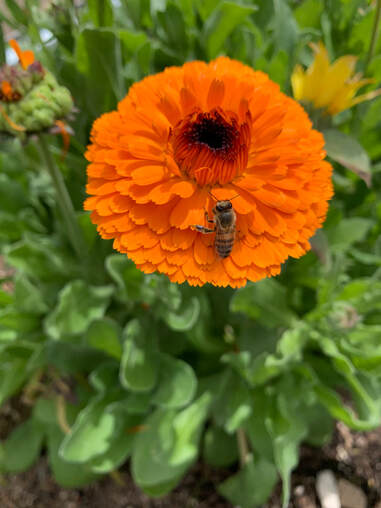|
German Chamomile, also known as Matricaria recutita, is a part of the Aster family (Asteraceae). The way I grew up knowing her was by calling her Manzanilla, the little apple. Why? Because she was often described as her flower smelling like an apple, or the tea tasting like a green apple. But what causes this flower to have the scent and smell of an apple?
Upon studying the components of German Chamomile for a case study, my goal was to look for the therapeutic properties of the essential oil. What I found was that one of the components of this magnificent flower is trans-B-farnesene. Although I could not find the therapeutic properties connected to this acyclic sesquiterpene alkene, this component serves a different olfactory purpose. What was interesting is that trans-B-farnesene is also found in green apple and the scent of green apple. The green apple and German Chamomile have the same scent because of trans-B-farnesene! Sometimes, looking up components for their therapeutic properties may lead you to not finding one, but leading you to the connection she has to another fruit of a plant, like green apple. I love Nature, don’t you? Many Blessings Resources: Ethan B. Russo, Jahan Marcu, in Advances in Pharmacology, 2017 https://www.sciencedirect.com/topics/pharmacology-toxicology-and-pharmaceutical-science/beta-farnesene
0 Comments
Symmetry is something that we have some basis of understanding of what that is. We may often see Symmetry in its geometric application on pieces of paper demanding for us to search for symmetry of a given object. But why? What application could this possibly have apart from this two-dimensional space? We possibly could extend our thinking of symmetry as balance, or something that is the same on both sides. When we walk out of our homes and offices, we could surely go out and observe in even the three-dimensional space, but how does this relate to a language of Nature that is often discussed over and over again?
One sense of the word, according to Wikipedia, is that it is an “agreement of dimensions, due proportion, and arrangement”. It was profound to see the words agreement of dimension. This definition resonated with me as it relates back to this language in Nature about an agreement of how things are created, an agreement of how they thrive, and an agreement with how they transition onto the next generation and season. In Nature, we may often feel and think that to thrive is to compete in order to survive. For most things, proportion and arrangement is agreed upon in order to maintain a balanced ecosystem for life. In all these things and in all that time and space in between those defining moments of life, is also a beautifully intricate art form of pollination and growth. When thinking about Symmetry, it is an art form that is agreed upon, but not necessarily always a competition, but an arrangement of understanding. In that result, the art form thus produces the sweetness of life. Let us consider the bee, for example, as the pollinator. It has taken thousands of generations of bees, more than that of course, to come up with the wisdom to decide which plants and trees to pollinate. As that transpired, there were subtle forms of communication transforming with the rest of the botanical world. The result of that communication was an evolved arrangement of stigma, stamen, pistil, and petals, all in balance and all in symmetry. The symmetry of this arrangement is extremely important as, according to Du Sautoy, “…provides a way of animals (bees) and plants to convey a multitude of messages, from genetic superiority to nutritional information” (pg. 11). Think of this as its own art form. This presentation is more than just something beautiful to look at, but a form of a Mathematical language that is communicated between pollinator and plant. Why? Because those flowers who are symmetrical, produce the sweetest culinary experience for the bee. “Symmetry tastes sweet” (Sautoy, pg. 12). Over an extensive period of time, Symmetry as proved itself to be part of the sweetness and art of pollination. Many Blessings References: Du Sautoy, M. (2008). Symmetry. (pgs. 11-12). Harper Collins Publishers. Wikipedia. (2021, February 13). Symmetry. Retrieved from https://en.wikipedia.org/wiki/Symmetry#cite_note-1 |
AuthorI am not the first, nor the last of expressing and sharing the beauty of mathematics in Nature. What I will share in this blog are thoughts, experiences, and lessons learned to validate life, both human and botanical, living mathematically. Archives
September 2021
Categories
All
|



 RSS Feed
RSS Feed
